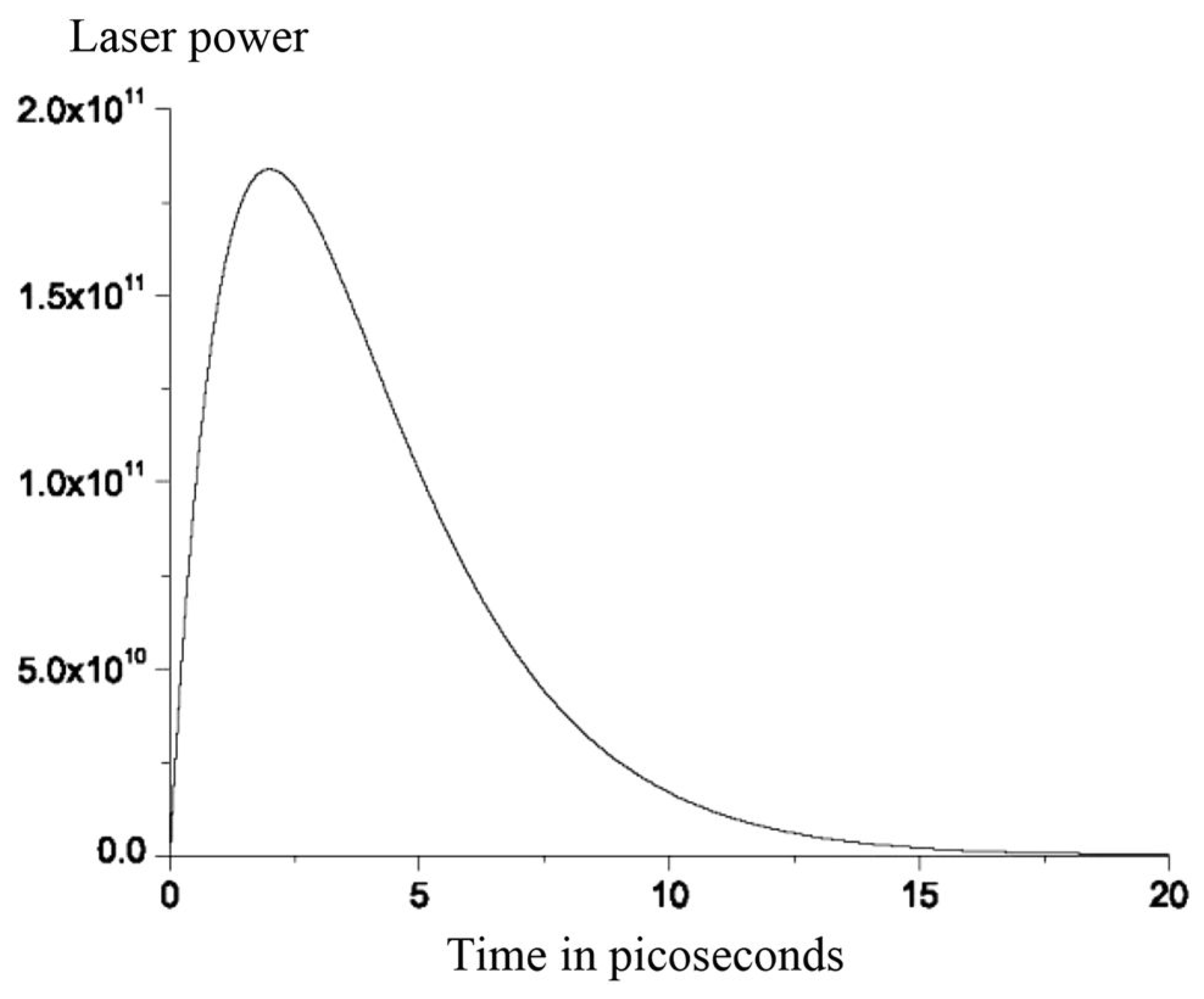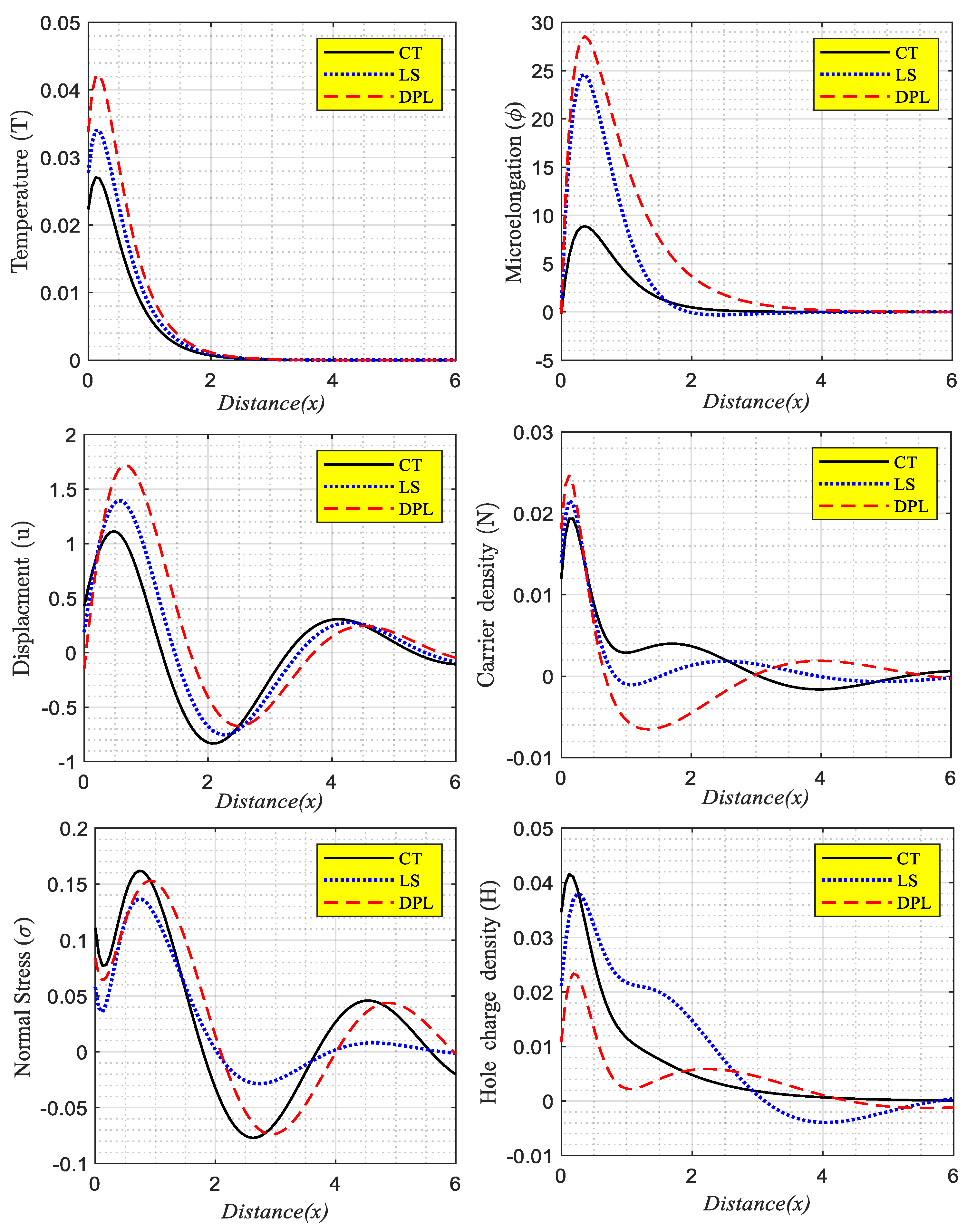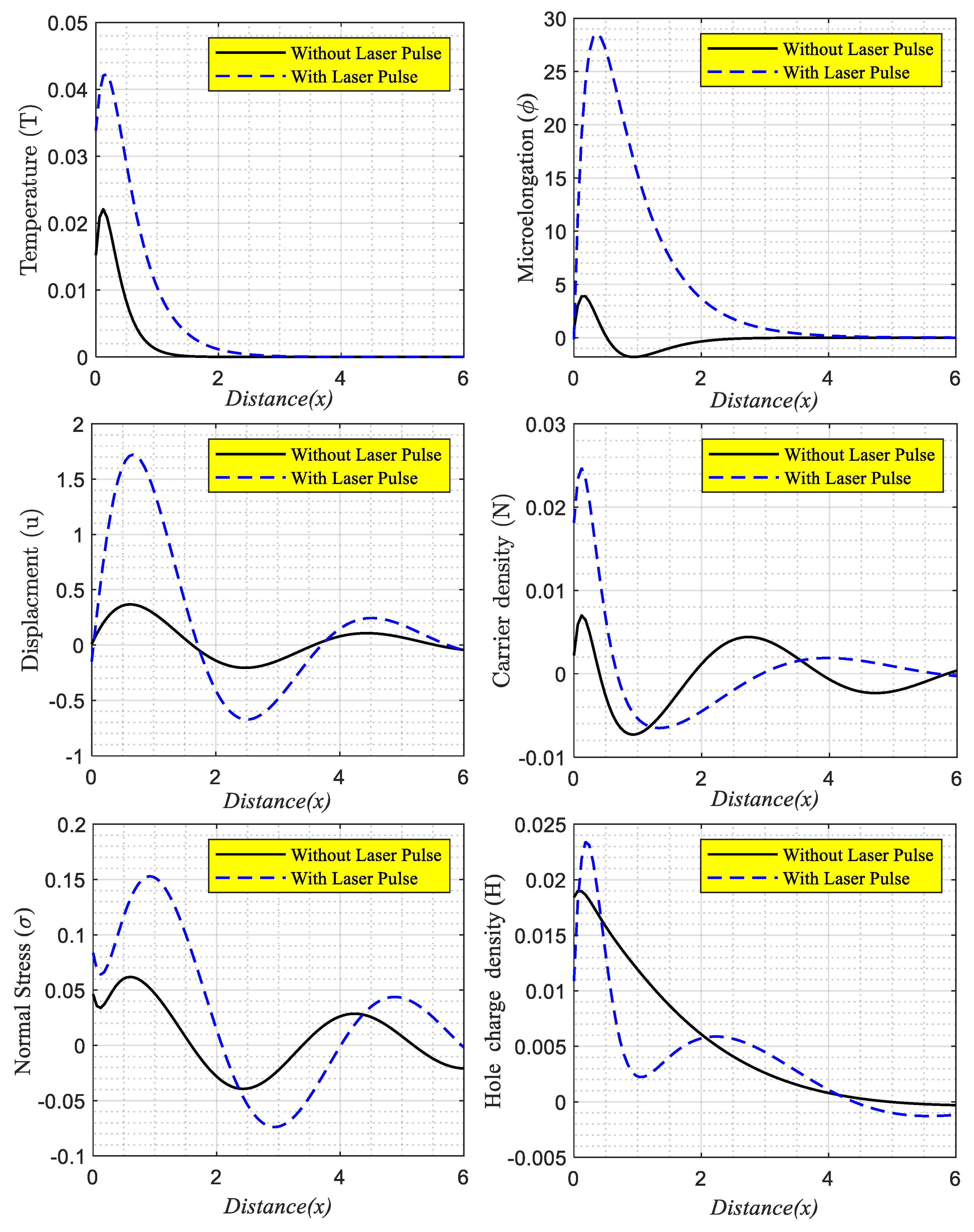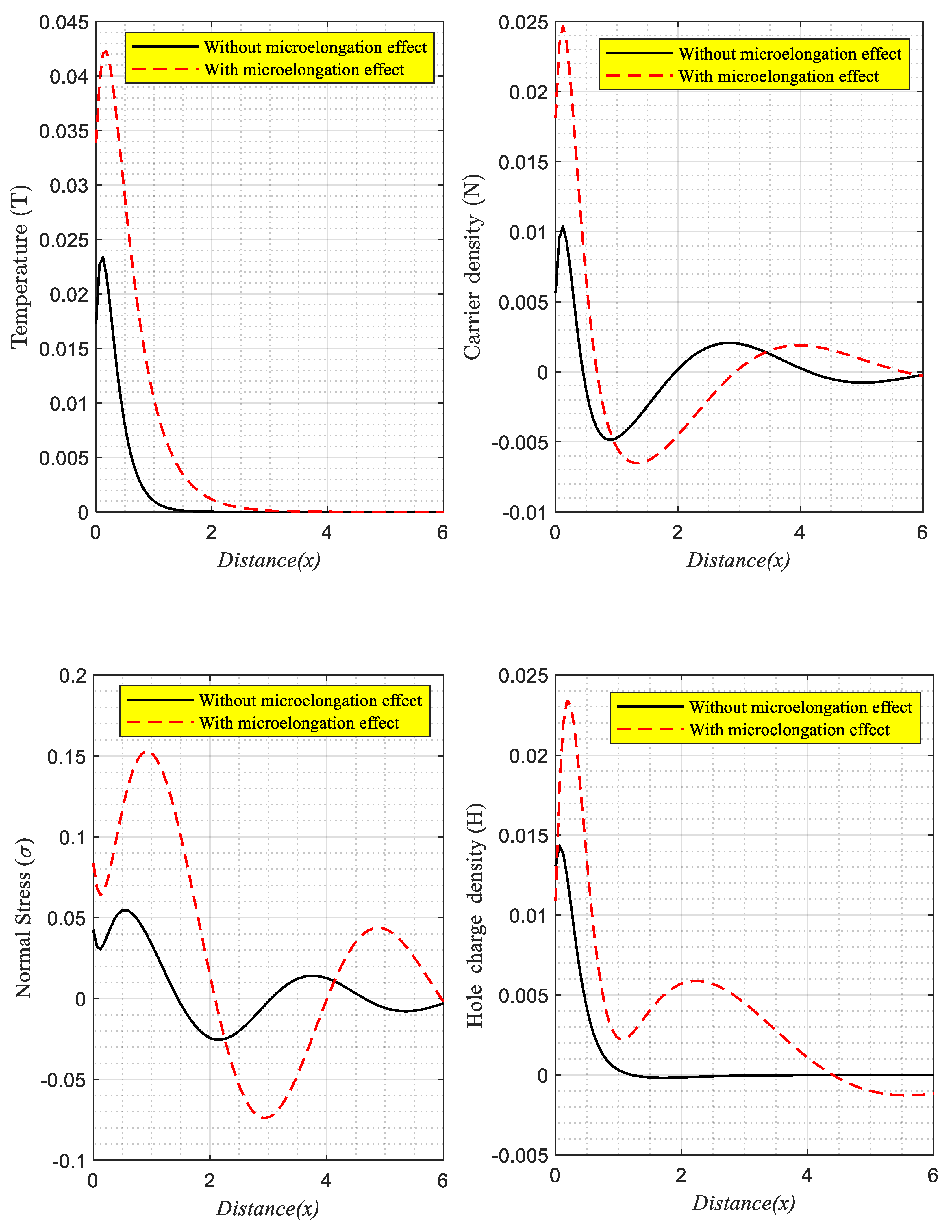Microelongated Thermo-Elastodiffusive Waves of Excited Semiconductor Material under Laser Pulses Impact
Abstract
:1. Introduction
2. Governing Equation
3. Analytical Solution Procedure
4. Applications
- (I)
- When , the pulsing heat flow boundary condition may be represented by the thermally gradient temperature in the following ways:
- (II)
- The load force may be expressed as follows when the Laplace transform is used, and it is regarded as a mechanical condition at the boundary :
- (III)
- The carriers are capable of obtaining the following value on the sample’s surface, , as they disperse, where they have a chance of undergoing recombination. Consequently, the following equation might be used to express the carrier density boundary condition. In this, the plasma condition under the Laplace transform is derived using the carrier density diffusive and is shown as follows:
- (IV)
- One may choose the microelongation condition as an elongation free on the surface :
- (V)
- On the other hand, the equilibrium concentration situation for the hole charge carrier field at the boundary condition may be obtained in this instance by using the Laplace transform:
5. Inversion of the Laplace Transforms
6. Validation
6.1. The Microelongated Thermoelasticity Models
6.2. The Influence of Microelongation Parameters
6.3. The Laser Pulses Impact
7. Numerical Results and Discussion
7.1. The Photo-Thermoelasticity Models
7.2. The Laser Pulses Effect
7.3. The Effect of Elongation Parameters
8. Conclusions
Author Contributions
Funding
Data Availability Statement
Acknowledgments
Conflicts of Interest
Nomenclature (The Physical Quantities with Units)
| Elastic Lame’s parameters. | |
| Deformation potential difference between conduction and valence band. | |
| The electronic deformation coefficient ED | |
| Reference temperature in its natural state | |
| Volume thermal expansion | |
| Stress tensor | |
| The density of the sample | |
| Linear thermal expansion | |
| The power intensity of the laser | |
| Specific heat at constant strain | |
| Thermal conductivity of the semiconductor medium | |
| The electrons relaxation time | |
| The lifetime of photogenerated carriers | |
| Energy gap | |
| Components of the strain tensor | |
| Peltier–Seebeck and Dufour–Soret-like constants | |
| The flux-like constants | |
| Thermal and elastic relaxation times | |
| Holes and electrons thermo-diffusive parameters | |
| , | The equilibrium value of electrons and holes concentration |
| The holes elastodiffusive parameter | |
| The coefficients of hole deformation | |
| Recombination velocities | |
| The diffusion coefficients of the electrons and holes | |
| Microelongational material parameters | |
| Components of the microstretch vector | |
| The scalar microelongational function | |
| Stress tensor component | |
| Kronecker delta | |
| The pulse parameter | |
| The optical absorption coefficient |
References
- Chteoui, R.; Lotfy, K.; El-Bary, A.A.; Allan, M.M. Hall Current Effect of Magnetic-Optical-Elastic-Thermal-Diffusive Non-Local Semiconductor Model during Electrons-Holes Excitation Processes. Crystals 2022, 12, 1680. [Google Scholar] [CrossRef]
- Saeed, A.M.; Lotfy, K.; Ahmed, M.H. Thermal-Optical Mechanical Waves of the Excited Microelongated Semiconductor Layer in a Rotational Field. Mathematics 2022, 10, 4660. [Google Scholar] [CrossRef]
- Saeed, A.M.; Lotfy, K.; El-Bary, A.A. Hall Current Effect of Magnetic-Optical-Elastic-Thermal-Diffusive Semiconductor Model during Electrons-Holes Excitation Processes. J. Math. 2022, 2022, 6597924. [Google Scholar] [CrossRef]
- Eringen, A.C.; Suhubi, E.S. Nonlinear theory of simple microelastic solids I. Int. J. Eng. Sci. 1964, 2, 189–203. [Google Scholar] [CrossRef]
- Suhubi, E.S.; Eringen, A.C. Nonlinear theory of micro-elastic II. Int. J. Eng. Sci. 1964, 2, 389–404. [Google Scholar] [CrossRef]
- Eringen, A.C. Linear theory of Micropolar Elasticity, ONR Technical Report No. 29. Ph.D. Thesis, School of Aeronautics, Aeronautics and Engineering Science, Purdue University, West Lafayette, IN, USA, 1965. [Google Scholar]
- Eringen, A.C. A unified theory of thermomechanical materials. Int. J. Eng. Sci. 1966, 4, 179–202. [Google Scholar] [CrossRef]
- Eringen, A.C. Linear theory of micropolar elasticity. J. Math. Mech. 1966, 15, 909–923. [Google Scholar]
- Eringen, A.C. Micropolar elastic solids with stretch. Ari Kitabevi Matbassi 1971, 24, 1–18. [Google Scholar]
- Youssef, H. Thermal shock problem of a generalized thermoelastic solid sphere affected by mechanical damage and thermal diffusion. J. Eng. Therm. Sci. 2021, 1, 1–16. [Google Scholar] [CrossRef]
- Eringen, A.C. Foundation of Micropolar Thermoelasticity, Courses and Lectures, No.23, CISM, Udine; Springer: Vienna, Austria; New York, NY, USA, 1970. [Google Scholar]
- Tauchert, T.R.; Claus, W.D.; Ariman, T. The linear theory of micropolar thermoelasticity. Int. J. Eng. Sci. 1968, 6, 37–47. [Google Scholar] [CrossRef]
- Nowacki, W.; Olszak, W. Micropolar Thermoelasticity. In Micropolar thermoelasticity, CISM Courses and Lectures, No. 151, Udine; Nowacki, W., Olszak, W., Eds.; Springer: Vienna, Austria, 1974. [Google Scholar]
- Lord, H.W.; Shulman, Y. A generalized dynamical theory of thermo-elasticity. J. Mech. Phys. Solids 1967, 15, 299–306. [Google Scholar] [CrossRef]
- Müller, I.M. The coldness, a universal function in thermoelastic bodies. Arch. Ration. Mech. Anal. 1971, 41, 319–332. [Google Scholar] [CrossRef]
- Green, A.E.; Laws, N. On the entropy production inequality. Arch. Ration. Mech. Anal. 1972, 45, 45–47. [Google Scholar] [CrossRef]
- Green, A.E.; Lindsay, K.A. Thermoelasticity. J. Elast. 1972, 2, 1–7. [Google Scholar] [CrossRef]
- Shaw, S.; Othman, M. On the concept of a conformable fractional differential equation. J. Eng. Therm. Sci. 2021, 1, 17–29. [Google Scholar] [CrossRef]
- Lata, P.; Singh, S. Rayleigh wave propagation in a nonlocal isotropic magneto-thermoelastic solid with multi-dual-phase lag heat transfer. GEM-Int. J. Geomath. 2022, 13, 1869–2672. [Google Scholar] [CrossRef]
- Kaur, I.; Lata, P.; Singh, K. Reflection of plane harmonic wave in rotating media with fractional order heat transfer and two temperature. Partial. Differ. Equ. Appl. Math. 2021, 4, 100049. [Google Scholar] [CrossRef]
- Kaur, I.; Lata, P.; Singh, K. Reflection and refraction of plane wave in piezo-thermoelastic diffusive half spaces with three phase lag memory dependent derivative and two-temperature. Waves Random Complex Media 2022, 32, 2499–2532. [Google Scholar] [CrossRef]
- Lata, P.; Singh, S. Effects of nonlocality and two temperature in a nonlocal thermoelastic solid due to ramp type heat source. Arab. J. Basic Appl. Sci. 2020, 27, 357–363. [Google Scholar] [CrossRef]
- Kaur, I.; Lata, P.; Singh, K. Forced Flexural Vibrations in a Thin Nonlocal Rectangular Plate with Kirchhoff’s Thin Plate Theory. Int. J. Struct. Stab. Dyn. 2020, 20, 1793–6764. [Google Scholar] [CrossRef]
- Maruszewski, B. Electro-magneto-thermo-elasticity of Extrinsic Semiconductors, Classical Irreversible Thermodynamic Approach. Arch. Mech. 1986, 38, 71–82. [Google Scholar]
- Maruszewski, B. Electro-magneto-thermo-elasticity of Extrinsic Semiconductors, Extended Irreversible Thermodynamic Approach. Arch. Mech. 1986, 38, 83–95. [Google Scholar]
- Sharma, J.N.; Thakur, N.T. Plane harmonic elasto-thermodiffusive waves in semiconductor materials. J. Mech. Mater. Struct. 2006, 1, 813–835. [Google Scholar] [CrossRef] [Green Version]
- Mandelis, A. Photoacoustic and Thermal Wave Phenomena in Semiconductors; Elsevier: New York, NY, USA, 1987. [Google Scholar]
- Almond, D.; Patel, P. Photothermal Science and Techniques; Springer Science & Business Media: Berlin, Germany, 1996. [Google Scholar]
- Gordon, J.P.; Leite, R.C.C.; Moore, R.S.; Porto, S.P.S.; Whinnery, J.R. Long-transient effects in lasers with inserted liquid samples. Bull. Am. Phys. Soc. 1964, 119, 501. [Google Scholar] [CrossRef]
- Lotfy, K. Effect of Variable Thermal Conductivity during the Photothermal Diffusion Process of Semiconductor Medium. Silicon 2019, 11, 1863–1873. [Google Scholar] [CrossRef]
- Lotfy, K.; Abo-Dahab, S.; Tantawy, R.; Anwar, N. Thermomechanical Response Model on a Reflection PhotothermalDiffusion Waves (RPTD) for Semiconductor Medium. Silicon 2020, 12, 199–209. [Google Scholar] [CrossRef]
- Alharbi, A.R.; Almatrafi, M.B.; Lotfy, K. Constructions of solitary travelling wave solutions for Ito integro-differential equation arising in plasma physics. Results Phys. 2020, 19, 103533. [Google Scholar] [CrossRef]
- Lotfy, K. A novel model of magneto photothermal diffusion (MPD) on polymer nano-composite semiconductor with initial stress. Waves Ran. Comp. Med. 2021, 31, 83–100. [Google Scholar] [CrossRef]
- Lotfy, K.; Elidy, E.S.; Tantawi, R. Piezo-photo-thermoelasticity transport process for hyperbolic two-temperature theory of semiconductor material. Int. J. Mod. Phys. C 2021, 32, 2150088. [Google Scholar] [CrossRef]
- Mahdy, A.M.S.; Lotfy, K.; El-Bary, A.; Tayel, I.M. Variable thermal conductivity and hyperbolic two-temperature theory during magneto-photothermal theory of semiconductor induced by laser pulses. Eur. Phys. J. Plus 2021, 136, 651. [Google Scholar] [CrossRef]
- Abbas, I.; Hobiny, A. Analytical-numerical solutions of photo-thermal interactions in semiconductor materials. Inf. Sci. Lett. 2021, 10, 189–196. [Google Scholar]
- Abbas, I.A.; Alzahrani, F.S.; Elaiw, A. A DPL model of photothermal interaction in a semiconductor material. Waves Random Complex Media 2019, 29, 328–343. [Google Scholar] [CrossRef]
- Khamis, A.K.; Lotfy, K.; El-Bary, A.A.; Mahdy, A.M.S.; Ahmed, M.H. Thermal-piezoelectric problem of a semiconductor medium during photo-thermal excitation. Waves Random Complex Media 2021, 31, 2499–2513. [Google Scholar] [CrossRef]
- Mahdy, A.; Lotfy, K.; Ismail, E.; El-Bary, A.; Ahmed, M.; El-Dahdouh, A. Analytical solutions of time-fractional heat order for a magneto-photothermal semiconductor medium with Thomson effects and initial stress. Results Phys. 2020, 18, 103174. [Google Scholar] [CrossRef]
- Mahdy, A.M.S.; Lotfy, K.; Hassan, W.; El-Bary, A.A. Analytical solution of magneto-photothermal theory during variable thermal conductivity of a semiconductor material due to pulse heat flux and volumetric heat source. Waves Random Complex Media 2021, 31, 2040–2057. [Google Scholar] [CrossRef]
- Lotfy, K. The elastic wave motions for a photothermal medium of a dual-phase-lag model with an internal heat source and gravitational field. Can. J. Phys. 2016, 94, 400–409. [Google Scholar] [CrossRef] [Green Version]
- Marin, M. A domain of influence theorem for microstretch elastic materials. Nonlinear Anal. Real World Appl. 2010, 11, 3446–3452. [Google Scholar] [CrossRef]
- Marin, M. A partition of energy in thermoelasticity of microstretch bodies. Nonlinear Anal. Real World Appl. 2010, 11, 2436–2447. [Google Scholar] [CrossRef]
- Brancik, L. Programs for fast numerical inversion of Laplace transforms in MATLAB language environment. In Proceedings of the 7th Conference MATLAB, Brno, Czech Republic, January 1999. [Google Scholar]
- Mahdy, A.M.S.; Lotfy, K.; El-Bary, A.; Sarhan, H.H. Effect of rotation and magnetic field on a numerical-refined heat conduction in a semiconductor medium during photo-excitation processes. Eur. Phys. J. Plus 2021, 136, 553. [Google Scholar] [CrossRef]
- Lotfy, K. A novel model for Photothermal excitation of variable thermal conductivity semiconductor elastic medium subjected to mechanical ramp type with two-temperature theory and magnetic field. Sci. Rep. 2019, 9, 3319. [Google Scholar] [CrossRef]
- Mondal, S.; Sur, A. Photo-thermo-elastic wave propagation in an orthotropic semiconductor with a spherical cavity and memory responses. Waves Random Complex Media 2020, 31, 1835–1858. [Google Scholar] [CrossRef]
- Aldwoah, K.A.; Lotfy, K.; Mhemdi, A.; El-Bary, A. A novel magneto-photo-elasto-thermodiffusion electrons-holes model of excited semiconductor. Case Stud. Therm. Eng. 2022, 32, 101877. [Google Scholar] [CrossRef]
- Alhejaili, W.; Lotfy, K.; El-Bary, A. Photo–elasto–thermodiffusion waves of semiconductor with ramp-type heating for electrons–holes-coupled model with initial stress. Waves Random Complex Media 2022, 22, 1–9. [Google Scholar] [CrossRef]
- Xiao, Y.; Shen, C.; Zhang, W.B. Screening and prediction of metal-doped α-borophene monolayer for nitric oxide elimination. Mater. Today Chem. 2022, 25, 100958. [Google Scholar] [CrossRef]
- Liu, J.; Han, M.; Wang, R.; Xu, S.; Wang, X. Photothermal phenomenon: Extended ideas for thermophysical properties characterization. J. Appl. Phys. 2022, 131, 065107. [Google Scholar] [CrossRef]




| Unit | Symbol | Value |
|---|---|---|
| Constants | 3 2 | |
Disclaimer/Publisher’s Note: The statements, opinions and data contained in all publications are solely those of the individual author(s) and contributor(s) and not of MDPI and/or the editor(s). MDPI and/or the editor(s) disclaim responsibility for any injury to people or property resulting from any ideas, methods, instructions or products referred to in the content. |
© 2023 by the authors. Licensee MDPI, Basel, Switzerland. This article is an open access article distributed under the terms and conditions of the Creative Commons Attribution (CC BY) license (https://creativecommons.org/licenses/by/4.0/).
Share and Cite
Tayel, I.M.; Lotfy, K.; El-Bary, A.A.; Alebraheem, J.; Mohammed, M.A.Y. Microelongated Thermo-Elastodiffusive Waves of Excited Semiconductor Material under Laser Pulses Impact. Mathematics 2023, 11, 1627. https://doi.org/10.3390/math11071627
Tayel IM, Lotfy K, El-Bary AA, Alebraheem J, Mohammed MAY. Microelongated Thermo-Elastodiffusive Waves of Excited Semiconductor Material under Laser Pulses Impact. Mathematics. 2023; 11(7):1627. https://doi.org/10.3390/math11071627
Chicago/Turabian StyleTayel, Ismail M., Kh. Lotfy, Alaa A. El-Bary, Jawdat Alebraheem, and Mogtaba A. Y. Mohammed. 2023. "Microelongated Thermo-Elastodiffusive Waves of Excited Semiconductor Material under Laser Pulses Impact" Mathematics 11, no. 7: 1627. https://doi.org/10.3390/math11071627
APA StyleTayel, I. M., Lotfy, K., El-Bary, A. A., Alebraheem, J., & Mohammed, M. A. Y. (2023). Microelongated Thermo-Elastodiffusive Waves of Excited Semiconductor Material under Laser Pulses Impact. Mathematics, 11(7), 1627. https://doi.org/10.3390/math11071627








